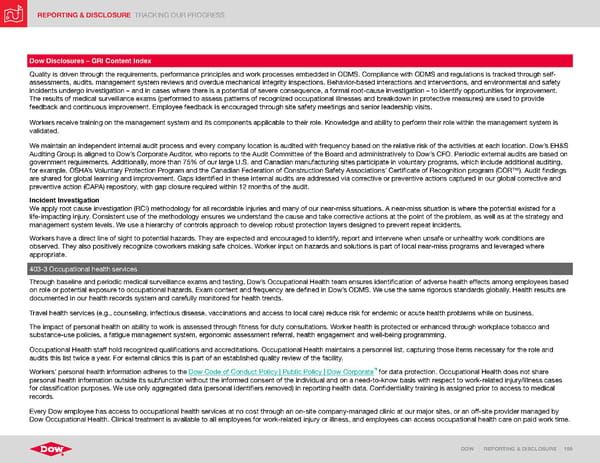REPORTING & DISCLOSURE TRACKING OUR PROGRESS DOW | REPORTING & DISCLOSURE | 159 Dow Disclosures – GRI Content Index Quality is driven through the requirements, performance principles and work processes embedded in ODMS. Compliance with ODMS and regulations is tracked through self- assessments, audits, management system reviews and overdue mechanical integrity inspections. Behavior-based interactions and interventions, and environmental and safety incidents undergo investigation – and in cases where there is a potential of severe consequence, a formal root-cause investigation – to identify opportunities for improvement. The results of medical surveillance exams (performed to assess patterns of recognized occupational illnesses and breakdown in protective measures) are used to provide feedback and continuous improvement. Employee feedback is encouraged through site safety meetings and senior leadership visits. Workers receive training on the management system and its components applicable to their role. Knowledge and ability to perform their role within the management system is validated. We maintain an independent internal audit process and every company location is audited with frequency based on the relative risk of the activities at each location. Dow’s EH&S Auditing Group is aligned to Dow’s Corporate Auditor, who reports to the Audit Committee of the Board and administratively to Dow’s CFO. Periodic external audits are based on government requirements. Additionally, more than 75% of our large U.S. and Canadian manufacturing sites participate in voluntary programs, which include additional auditing, for example, OSHA’s Voluntary Protection Program and the Canadian Federation of Construction Safety Associations’ Certificate of Recognition program (COR™). Audit findings are shared for global learning and improvement. Gaps identified in these internal audits are addressed via corrective or preventive actions captured in our global corrective and preventive action (CAPA) repository, with gap closure required within 12 months of the audit. Incident Investigation We apply root cause investigation (RCI) methodology for all recordable injuries and many of our near-miss situations. A near-miss situation is where the potential existed for a life-impacting injury. Consistent use of the methodology ensures we understand the cause and take corrective actions at the point of the problem, as well as at the strategy and management system levels. We use a hierarchy of controls approach to develop robust protection layers designed to prevent repeat incidents. Workers have a direct line of sight to potential hazards. They are expected and encouraged to identify, report and intervene when unsafe or unhealthy work conditions are observed. They also positively recognize coworkers making safe choices. Worker input on hazards and solutions is part of local near-miss programs and leveraged where appropriate. 403-3 Occupational health services Through baseline and periodic medical surveillance exams and testing, Dow’s Occupational Health team ensures identification of adverse health effects among employees based on role or potential exposure to occupational hazards. Exam content and frequency are defined in Dow’s ODMS. We use the same rigorous standards globally. Health results are documented in our health records system and carefully monitored for health trends. Travel health services (e.g., counseling, infectious disease, vaccinations and access to local care) reduce risk for endemic or acute health problems while on business. The impact of personal health on ability to work is assessed through fitness for duty consultations. Worker health is protected or enhanced through workplace tobacco and substance-use policies, a fatigue management system, ergonomic assessment referral, health engagement and well-being programming. Occupational Health staff hold recognized qualifications and accreditations. Occupational Health maintains a personnel list, capturing those items necessary for the role and audits this list twice a year. For external clinics this is part of an established quality review of the facility. Workers’ personal health information adheres to the Dow Code of Conduct Policy | Public Policy | Dow Corporate for data protection. Occupational Health does not share personal health information outside its subfunction without the informed consent of the individual and on a need-to-know basis with respect to work-related injury/illness cases for classification purposes. We use only aggregated data (personal identifiers removed) in reporting health data. Confidentiality training is assigned prior to access to medical records. Every Dow employee has access to occupational health services at no cost through an on-site company-managed clinic at our major sites, or an off-site provider managed by Dow Occupational Health. Clinical treatment is available to all employees for work-related injury or illness, and employees can access occupational health care on paid work time.
 ESG Report | Dow Page 158 Page 160
ESG Report | Dow Page 158 Page 160